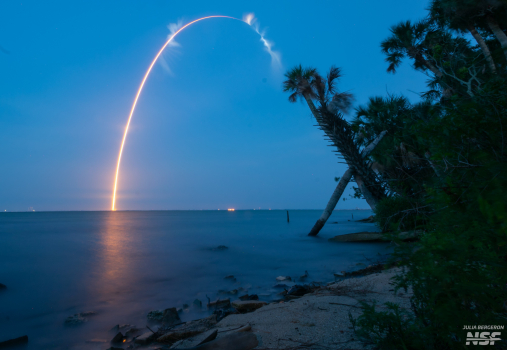
SpaceX’s Falcon 9 Dominates the Skies, Reaching a Historic Milestone
In a week marked by notable activity in the space sector, SpaceX celebrated a significant achievement. The company successfully completed the 500th orbital flight of its reliable Falcon 9 rocket. This landmark event underscores SpaceX’s consistent presence and leadership in the realm of space exploration and satellite launches. Beyond the United States, the global space community is also buzzing with anticipation. Gilmour Space, an Australian company, is gearing up to attempt the inaugural launch of its Eris launch vehicle. This marks a crucial moment for Australia’s space ambitions and adds to the dynamic nature of the global space industry. The past few weeks have witnessed a high tempo of orbital launches worldwide, often exceeding ten missions from various launch sites. The recent Starlink Group 15-7 mission was the final orbital launch of the first half of 2025. This mission wasn’t just another launch; it was the 500th time a Falcon 9 took to the skies, considering the suborbital Crew Dragon in-flight abort test conducted in 2020.
Falcon 9’s Remarkable Achievements and Records
SpaceX has set new benchmarks in the space industry. Booster B1067 became the first in the fleet to achieve 29 flights. The company broke records in late June with back-to-back launches from Florida and California, sending the Starlink Group 10-34 and Group 15-7 missions into orbit. These launches were SpaceX’s 80th and 81st Falcon missions of the year. The company established a new pad turnaround record of just 56 hours, 31 minutes, and 10 seconds at Space Launch Complex 40 (SLC-40). This remarkable feat demonstrates SpaceX’s efficiency and dedication to rapid launch capabilities. Furthermore, SpaceX also set a new five-day record on the west coast, in Vandenberg. They turned booster B1088 around from its arrival via barge to its subsequent launch during the second of those two missions. The first half of the year closed with a total of 142 orbital launches across the globe. These missions lofted over 2,130 payloads and 15 humans into orbit. This impressive cadence reflects a 16% increase compared to the 122 orbital launches witnessed during the same period in 2024.
The Starlink Group 15-7 Mission: A Closer Look
The Starlink Group 15-7 mission was a crucial element of the overall count. It marked the 500th orbital launch of a Falcon 9. The first Falcon 9 flight occurred over 15 years ago, on June 4, 2010. The recent launch took place on Tuesday, July 8, at 4:21 AM EDT (08:21 UTC). The launch occurred from SLC-40 at the Cape Canaveral Space Force Station in Florida. The mission carried a batch of 28 Starlink v2-Mini high-speed internet communications satellites. These satellites were destined for low-Earth orbit at an altitude of 279 km and inclined at 53.16 degrees. This was the 19th mission into this specific shell, with the majority of launches originating from this pad. Recent missions, building the Group 10 shell, have typically carried 27 satellites. The Starlink Group 10-18 mission was the last time a batch of 28 satellites was sent into orbit, also launching from the same pad on June 18. Booster B1077 supported this mission on its 22nd flight. It landed on the deck of the droneship A Shortfall of Gravitas approximately eight minutes into the mission. SpaceX has now attempted 490 recoveries.
Upcoming Launch: GTO Mission
Another launch is expected from SLC-40 on Sunday, July 13, at 12:00 AM EDT (04:00 UTC on July 12), based on NOTAMs. This mission is heading to a geostationary transfer orbit and is believed to be for the Israeli Dror 1 communications satellite. Details about the satellite are limited, but it has a launch mass of about 4,000 kg. It was constructed on the Israel Aerospace Industries AMOS-HP bus, with an expected lifespan of about 14 years. Intelsat is providing launch and early orbit phase (LEOP) services for the spacecraft. This mission highlights the continued collaboration and innovation within the space industry.
Australia’s Eris Rocket Poised for Launch
Gilmour Space is preparing for the second attempt at the maiden launch of its Eris small satellite rocket. The launch is scheduled for Wednesday, July 15, at 7:30 AM AEST (21:30 UTC on Tuesday, July 15). The company had to postpone its initial attempt, which was planned for May 16. Issues arose when the fairings were prematurely triggered by the separation system during pre-launch preparations. An unexpected power surge from other devices caused the vehicle to shut down. The launch will take place from the Bowen Orbital Spaceport at Abbot Point, north of the coastal town of Bowen. The rocket proudly displays “Australian-made” on its body. TestFlight1 is set to be the first orbital launch from Australian soil using a domestically built vehicle. The Eris rocket, comparable to Rocket Lab’s Electron, stands 25 meters tall. It features a 1.5-meter fairing and can carry a payload of up to 215 kg to a 500 km Sun-synchronous orbit, or 305 kg to 500 km equatorial orbits. The first stage is powered by four Sirius engines. It’s a proprietary hybrid engine that utilizes a 3D-printed solid fuel grain and hydrogen peroxide as the oxidizer. A single Sirius engine powers the second stage. A successful orbital launch would also be a first for a hybrid rocket design.
A New Era in Space Exploration
The world of space exploration is dynamic and constantly evolving. SpaceX’s Falcon 9 reaching its 500th launch milestone highlights the industry’s rapid progress. Concurrently, Australia’s Gilmour Space is on the cusp of making history with the Eris rocket’s first orbital launch attempt. These events symbolize the advancements, competition, and global collaboration that are characteristic of modern space exploration. As we look forward, the continued innovation, technological leaps, and the ambition of both established and emerging spacefaring nations will shape the future of space exploration and its countless benefits to Earth.
